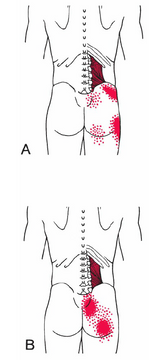Trigger points and their referred pain patterns are some of the sneakiest causes of pain on Earth. Trigger points cause constant muscle tension, which wrenches on joints and produces pain in the body. The best way to determine which trigger points contribute to your pain is by looking at a trigger point chart to find which muscles are the source of your pain. This post is going to use the pesky lower back trigger points as an example of how to analyze your chart and solve your pain.

QL Muscle Trigger Point Chart [1]
What Is A Trigger Point Chart?
A trigger point chart, also known as a pain referral pattern, shows wear a muscle predictably refers pain in the body. If this is a foreign concept, this article on referred back pain can help, but in a nutshell, muscles can refer pain away from where they are actually located. As Davies says in [2] it is a mistake to assume the source of the pain is where the pain is felt.

Piriformis Muscle Trigger Point Chart [1]
The two examples above show trigger point charts for the QL and Piriformis muscles. The images show where the pain is felt in bright red, and where the actual muscle is in dark red. As you can see, the pain referral pattern is not exactly where the muscle at the source is. The trigger point charts, originally created by Travell & Simons [1], eliminate the guesswork and tell you exactly where the pain you feel could be caused.
Analyzing Your Trigger Point Chart
Diving into your trigger point chart and pain referral pattern can be intimidating. If referencing the two books I used as sources here, they are conveniently sectioned into chapters of pain based on area - for example, lower back, buttock, and hip pain is one section, and head and neck pain is another.

Gluteus Minimus Trigger Point Chart [1]
When figuring out my own lower back pain, I analyzed every muscle that had a trigger point chart anywhere near the lower back. From there isolated 5 muscles - QL, Psoas, Iliacus, Gluteus Medius, and Piriformis - that aligned with my pain pattern and symptoms.
It is important to be thorough and not leave any muscle out, no matter how unlikely it may seem. Trigger point pain can be held in muscles for decades, and it will often cause pain until you physically work them out. Trust the trigger point chart patterns and spend the time learning the muscles so you can beat your pain for good - this is what myself and many others have done and it was worth every minute!
Conquering Your Trigger Point Chart
Once you have identified your trigger point pain chart and which muscles contribute to your pain, it is time to take action to relieve it.

Iliacus & Psoas (Iliopsoas) Trigger Point Chart [1]
The best way to release trigger points and pain is physical deep-tissue massage. Effective massage will break up all muscle fibers of their constant tension and release pressure wherever they cause pain. Deep tissue massage can be done by the hands of a professional, or at home with a lower back trigger point-specific tool like QL Claw. I designed QL Claw to release the 5 muscles that contributed to my crippling lower back pain and can't recommend it enough. The Claw was my ticket out of pain and it could be yours too!

QL Claw On QL Lower Back Trigger Points
Trigger Points Chart FAQ:
What Is a Myofascial Pain Syndrome Trigger Point Chart?
Myofascial pain syndrome is just another term for trigger points. The phrases "trigger points", "muscle tension", "muscle knots", "myofascial pain", etc. all refer to the same thing - muscles causing pain. (Also check out our page on Which Body Region Should be Avoided During Myofascial Release Techniques.)
How To Read A Trigger Point Chart:
A trigger point chart displays where the pain is felt in the body - not necessarily where the pain source is. Line up the appropriate trigger point chart for your pain pattern, follow which muscle refers to that pain pattern, and work that muscle to relieve the pain.
Back Trigger Points Chart Information:
For a deep and exhaustive guide on the lower back, leg, shoulder, you-name-it muscle trigger points - check out the sources below. Travell and Simons (source 1) wrote a 2000+ page textbook on the subject, and it is the most thorough trigger point chart literature available.
Trigger Point Chart References
I can't take credit for the trigger point chart knowledge or references in this post. The two sources below are the root of everything I know, and the reason I got out of 4 years of lower back pain and live pain-free today. Check them out and conquer your pain today!
Sources:
[1] Donnelly, Joseph M. Travell, Simons & Simons Myofascial Pain and Dysfunction: the Trigger Point Manual. 3rd ed., Wolters Kluwer Health, 2019.
[2] Davies, Clair, and Amber Davies. The Trigger Point Therapy Workbook: Your Self-Treatment Guide for Pain Relief. 3rd ed., New Harbinger Publications, Inc., 2013.


